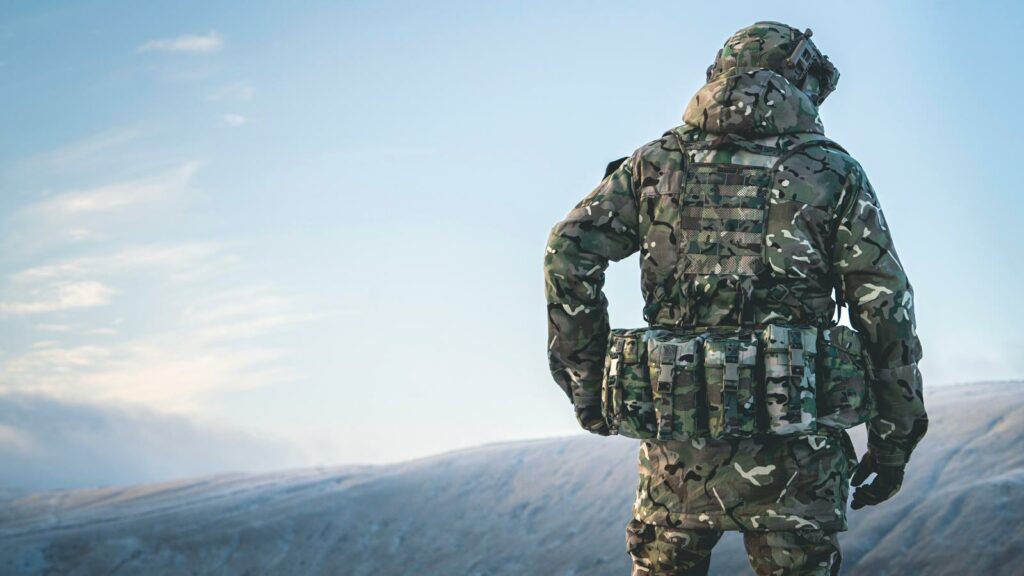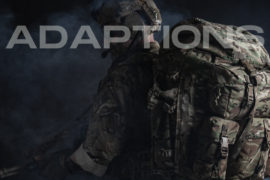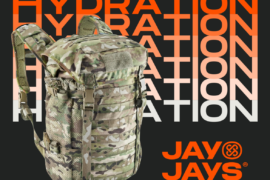There are many commanders’ webbings dating back to the First World War.
The 1908 Pattern Web Infantry Equipment was an innovative type of webbing equipment adopted by the British Army before World War I.
During the Second Boer War of 1899–1902, the standard British Army set of personal equipment, comprising a belt, haversack and ammunition pouches, was the leather Slade-Wallace Equipment, which had been introduced in 1888. It proved unsuitable for holding modern ammunition, which was carried in stripper clips instead of as individual rounds, and its buffalo-hide leather tended to deteriorate during long periods in the field. A review of British shortcomings during the war was conducted by the 1903 Royal Commission on the War in South Africa, which heard evidence that the Slade-Wallace equipment was “an absurdity” and “cumbersome, heavy and badly balanced”. As a stop-gap measure, the leather 1903 Bandolier Equipment, based on that used by the Boer Commandos, was issued, but it quickly proved to be unsuitable for infantry use.
In 1906, Major Arnold R. Burrowes of the Royal Irish Fusiliers, working with the Mills Equipment Company, presented a design for a new set of equipment. Mills’ American parent company had previously produced woven cotton webbing equipment for the US Army, but no European army had yet adopted it. The new Mills-Burrowes equipment, initially known as “the Aldershot design”, was presented to a committee chaired by the Surgeon-General, which in turn recommended trials at home and abroad. Following the success of these trials, the webbing equipment was accepted by the Army Council in December 1907.
(SOURCE: 1908 Pattern Webbing – Wikipedia )

As said previously, the Slade- Wallace Equipment looked like this, as this is a major step back from today’s commander’s webbing set.
(SOURCE: Slade-Wallace Equipment – Wikipedia )
Description
The 1908 equipment, when fully assembled, formed a single piece, and could be put on or taken off like a jacket. Ammunition was stored in two sets of pouches attached to the belt at the front, and the straps from these passed over the shoulders, crossing diagonally at the back. The large pack, or “valise”, or the haversack could be attached to these diagonal straps, thus spreading their weight. The “D” shaped buckles and the strap ends were made of brass. The Haversack would have carried: rations, a mess tin, a white towel, wool shirt, wool socks, a holdall, and a rifle cleaning kit. The holdall would have carried a spoon, knife, fork, button stick, shaving brush, hair comb, toothbrush, razor, a bar of soap, and spare boot laces. The whole set consisted of:
- One belt, three inches (76 mm) wide
- Two braces, two inches (51 mm) wide
- Two cartridge pouch sets, each set consisting of five pouches and each pouch holding three five-round stripper clips; 150 rounds of rifle ammunition in total.
- One bayonet frog (a tubular carrier which connected the bayonet scabbard to the belt)
- One water bottle and carrier
- One haversack
- One valise
- Two valise straps
- One entrenching tool with separate carriers for the head and helve
The equipment could be configured in two different ways; for “Full Marching Order” the valise was worn on the back and the haversack was worn hanging at the left hip. In “Battle Order” which was intended to be worn in combat, the valise was detached and the haversack was attached to the back in its place, connected to the ammunition pouches by separate straps.
In theory, an infantryman’s Full Marching Order weighed 57 pounds 2½ ounces (25.9 kilograms), and the Battle Order weighed 49 pounds 2 ounces (22.3 kilograms), both including the bayonet and 150 rounds of ammunition but excluding the Lee-Enfield rifle. However, in wartime conditions, the addition of new equipment such as the gas mask, steel helmet and hand grenades, together with the need to carry extra ammunition, rations and defence stores, meant that infantrymen could sometimes go into battle carrying loads estimated at up to 114 pounds (52 kilograms)
(SOURCE: 1908 Pattern Webbing – Wikipedia )
In this image we see soldiers from Leicestershire Regiment in Full Marching Order.
The valise or large pack is being worn and the haversack can be seen on the left side.
The entrenching tool helve and bayonet scabbard can also be seen in this image.

WW2 equipment:
1937 Pattern Web Equipment (also known as ’37 Webbing’) was an item of military load-carrying equipment. It replaced the 1908 Pattern and 1925 Pattern—on which it was based—and was standard issue for British and Commonwealth troops from its introduction in 1937, throughout World War II, and in the post-war period until it was superseded by 58 pattern webbing. It remained in limited use with second line troops until the mid to late 1980s.
Development:
At the end of the First World War, huge stocks of 1908 Pattern equipment remained, and the difficult financial climate meant that these remained in service with the British Army in the post-war period. In 1932, the Chief of the Imperial General Staff established the Brathwaite Committee to look into the uniform and equipment of the infantry and to make recommendations for their improvement. The increasingly complex nature of combat and different roles that soldiers and members of the other services were being required to undertake, meant that the new design needed to be flexible, thus it was decided that it would consist of interchangeable components, which could be modified to suit the individual needs of a soldier based on his role. In 1932, the Mills Equipment Company, the prime manufacturer of the 1908 equipment, offered the Brathwaite Committee four new designs to consider. Although the committee decided on one of the designs in 1934, the ongoing trials to find a successor to the Lewis gun that resulted in the Bren gun, and also abortive trials of automatic rifles including the Pedersen rifle, meant that new webbing could not be adopted until decisions had been reached on future weaponry.
The design was confirmed on 8 June 1938 and wide-scale issue began in 1939. Towards the end of World War II, some 37 Webbing was produced in jungle green for troops fighting in the Pacific Theatre, although purpose-made 44 Pattern Webbing was then introduced for the humid jungle conditions, being lighter in weight, quicker drying and rot-proofed. Although 44 Pattern continued in use with the British Army for jungle warfare in its various post-World War II colonial conflicts, it did not replace 37 Pattern in general service, which was in front-line use up until the introduction of 58 Pattern. However, 37 Pattern was used for second line and support troops and was included in the army’s Catalogue of Ordnance Stores and Ammunition (C.O.S.A.) in 1985, but had finally disappeared by the time of the 1991 edition.
(SOURCE: 1937 Pattern Web Equipment – Wikipedia )
Basic Components:
- Small Pack( Haversack): A rectangular pack that attached to the brace ends on the left hip. It was partitioned in the middle and the rear partition was split in two with two Mess Tins stored in one side containing washing and shaving kit, knife, fork and spoon and housewife (sewing kit). Spare shirt, pair of socks, pair of draws cellular and hand towel. The ground sheet/rain cape folded to cushion the back with part showing under the packs flap. It was worn on the back when the large pack was not worn.
- Binoculars Case: A box that carried the Binoculars Pouch and binoculars. The back of the case attached to the web belt with two long oval metal hooks. The same case could also be used for carrying the iron sight for the tripod-mounted BREN gun; it came in a fitted wooden box to cushion and protect it.
- Compass Pouch: A square pouch that was the same size and shape as the pistol ammunition pouch except it was felt-lined to cushion the compass. It sat above the Binoculars Case attached to the right-side shoulder strap.
- Mess Tin: A new pattern of mess tin was developed for the Web Equipment 1937 Pattern, which was a nested, two-piece rectangular mess tin with long, folding handles. An enamelled tin mug was used for drinking hot liquids. The water bottle of the 1908 Pattern Web Equipment was unchanged, though the web carrier was changed to incorporate the 1-inch-wide brace ends of the 1937 gear.
- Water Bottle: The Mark VII water bottle was attached to the brace ends on the right hip in either a ‘skeleton’ or ‘bucket’ style webbing carrier.
- Large Pack: A rectangular pack worn on the back with the Small Pack (haversack) carried on the left hip. The large pack contained the Great Coat, spare shirt, pair of socks and a pair of draws cellular.
- Basic Pouches: Two pouches were carried on the belt (front), one held two Bren magazines, the other a singular spare Bren magazine and a bandolier. They were retained by the left and right shoulder straps.
- FSMO (Field Service Marching Order, all equipment carried by infantrymen): This included, Large Pack, Small Pack(left side), Bren Magazine Pouches and Water Bottle.
- Battle Order: Small Pack, two Basic pouches, a bayonet frog (left side) and Water Bottle(right side).
- Holsters
- Pistol Case: A cross-draw belt holster worn on the left hip that was designed to carry the Enfield No 2 Revolver.
- Pistol Case, Royal Tank Corps (1916–1939) / Royal Armoured Corps (1939–Present): A straight-draw thigh holster worn on the right thigh that was used by Tank commanders to carry the Enfield No 2 Revolver. It had a long strap that allowed it to extend to the upper leg and a tie-down strap on the holster to secure it. It had six cartridge loops on the side of the holster to hold spare ammunition and a cleaning rod pocket along the front edge. There are pictures showing Commandos wearing a cross-draw shoulder holster worn under the left armpit made from a converted version of this rig.
- Pistol Case, Parachute Regiment: A thigh holster designed to carry the Colt 1911 ACP Automatic Pistol. Similar in design to the other pistol holsters other than being longer to allow for the longer barrel and for the end of the barrel section to be leather, rather than woven.
- Ammunition carriers
- The system could be used to flexibly mix and match components, but regulations usually had soldiers wear set combinations.
- Grenade Carrier: A horizontal rectangular case with two pouches. Each pouch could carry a No 36M Mills Bomb Fragmentation Grenade. The back of the carrier slid on the web belt with two long oval metal hooks. It was designed to be worn on the side of the belt on the hip rather than the front and therefore has no shoulder strap link.
- Basic Pouch: A large vertical rectangular pouch that went through three versions (Marks I, II, and III). It could carry either (2) BREN magazines, (6) 20-round Thompson SMG magazines, (4) No 36M Fragmentation, No 69 Offensive, or No.77 White Phosphorus grenades, (4) No 36M cup-discharger rifle grenades with attached gas-check baseplates, (2) Smoke Grenades, or boxes of Small Arms Ammunition. The Mark I version had three cartridge loops sewn into the inner lid for carrying three ballistite Rifle Grenade Blanks for launching rifle grenades; this feature was later omitted on the Mark II pouch. The longer Basic Pouch Mark III could hold (5) 32-round STEN Machine Carbine Magazines.
- Pistol Ammunition Pouch: A small pouch that carried a rectangular box of (12) rounds of .38/200 ammunition for the Enfield No 2 Revolver. It could be secured between the Pistol Case and the left brace.
- Cartridge Carrier: A horizontal rectangular case with two square pouches that carried a total of 20 rounds (4 × 5-round clips). It was designed for use by non-infantry soldiers who carried a rifle. Each pouch contained (2) 5-round chargers that were separated by a cloth divider. The pouch had two snaps: the bottom snap was used if only one clip was carried and the top snap was used if both clips were carried. The back of the carrier attached to the web belt with two long oval metal hooks and the top had a strap that linked into the shoulder strap.
- Lanchester Magazine Pouch: This long rectangular pouch carried (3) 50-round magazines for the Lanchester Machine Carbine that was used by the Royal Marines, Royal Navy and RAF. The back of the carrier slid on the web belt with two long oval metal hooks and the top had a short strap that linked into the shoulder strap. It was so high that it went almost up to the wearer’s chin.
- Vickers G.O. Gun Magazine Pouch, Alternate: This was an oval pouch designed to hold a drum for the Vickers K machine gun. It could hold a 100-round drum. The back of the carrier slid on the web belt with two long oval metal hooks and the top had a strap that linked into the shoulder strap.
Accessories
- Bandolier: A rectangular piece of cloth with 5 pockets and a shoulder strap. Each pocket carried (2) 5-round Mauser-style stripper clips for a total of 50 rounds. It went through 3 marks and 4 versions during the war (Marks I, II, III, and III/1).
- Utility Pouch: A pair of large vertical rectangular pouches with a built-in cloth yoke and a narrow strap for securing across the chest. It was a bigger version of the Basic Pouch. The yoke could be worn over the neck and the pouches across the chest or worn over the shoulder with the pouches across one side. Each pouch could carry either (3) BREN gun magazines, (2) Boys Anti-Tank Rifle magazines, (3) 2-inch O.S.B. mortar shells, a Mark VII water bottle, several grenades, or boxes of Small Arms Ammunition.
(SOURCE: 1937 Pattern Web Equipment – Wikipedia )
Since WW1 and WW2, we have majorly upgraded our technology, equipment, materials, and design for load carriage.
This is pulling us through into the Twenty-First century webbing designs, as of today we wear some pieces of kit in certain environments, and use certain items in the kit dependnt of how long you will be in the field- which is also explained in our blog… (Tactical Clothing / Gear 101 – Genuine JayJays )
As it is, The Gen 4 Commanders Webbing – MultiCam, is one of the best designed commanders webbing set; this is because everything has modernized incredibly since WW1 and 2.

Let’s look at the JAYJAYS Gen 4 Commanders Webbing, it is a flexible belt kit with the pouches permanently fixed and stitched to the pad. Our most popular webbing set.
JayJays® has now been open for 30 years, and we are the UK market leader in fixed/stitched webbing systems. During this time our webbing and belt kits have been constantly developed. Subtle design changes and features over the years have made this the preferred belt kit of the British Soldier.
Fixed pouches allow us to cater for users with a smaller waist size. Due to clever design methods, we are able keep the same number of pouches required and sew them to pads of differing lengths, thus making the belt kit a perfect fit for the user.
The design of the Gen IV reduces bounce of the belt kit. When all the pouches are full, they stabilise against each other, making a solid form that does not bounce or rock. This, combined with the spacer pad, ensures an ergonomic and overall comfortable fit.
The latest version of the Gen IV comprises of all polymer hardware, making it rust resistant in jungle and wet environments. The addition of the polymer hardware also reduces overall weight without compromising strength and reduces the risk of secondary blast injuries.
Spacetec spacer fabric is used for padding. This allows it to be as breathable as possible, but still very flexible so it hugs the body.
We have a video on YouTube explaining the Gen 4 Commanders webbing, linked below:
( (120) Gen IV Commander’s Multicam Webbing – YouTube )
This will help you understand the webbing to its fullest degree- any more questions you need to know leave a comment on the blog and we will get back to you!
As it stands the next GEN up from this is the Gen 5 Commanders Webbing which we know you all are so eager for. This Webbing set will be in production by the end of this year. So, keep your eyes peeled for more information!
Have a browse on our website, for more product descriptions and a wide variety of superb quality and lifetime warrantied kit.

Jay Jay’s was founded in 1993 by our team of former Police and Military personnel. We’ve been manufacturing load-bearing equipment and supplying clothing for the military for thirty years. Our innovative, built-for-life products and industry-leading customer service have earned us an outstanding reputation that we’re incredibly proud of.
Why not try for yourself?
Copyright © 2023 Genuine JayJays Ltd





